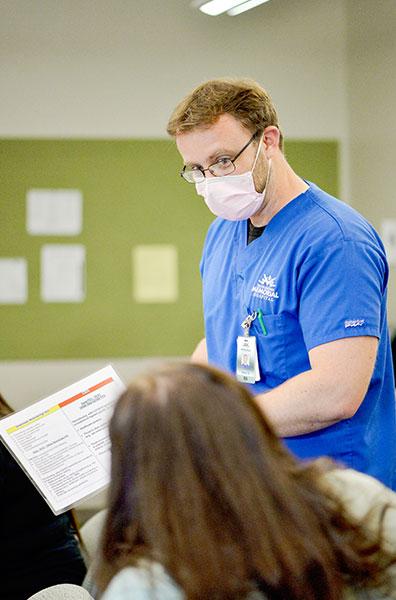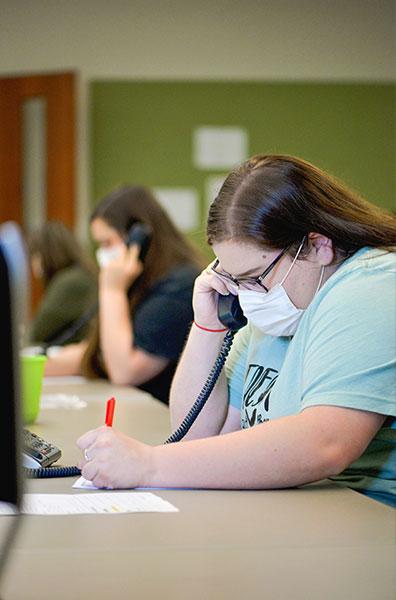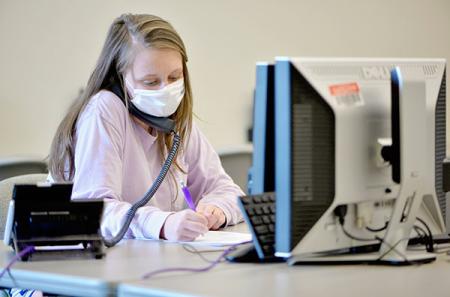Nursing students volunteer at call center during pandemic
Story by Joanna Armstrong '17
Photos by Robin Johnson '99 & '19
During the spring at the Nacogdoches County coronavirus call center and testing site, faculty members and students from SFA’s DeWitt School of Nursing spent their time answering calls and providing relief to overworked medical professionals and members of the community by screening patients for the coronavirus and addressing their concerns.
Established as a collaboration among the School of Nursing, Nacogdoches Medical Center Health Network, Nacogdoches Memorial Health, Excel ER, East Texas Community Health Services, and local physicians and government officials, the call center and testing site opened March 25. It operated for about two months with volunteers logging more than 2,700 calls and health care providers completing 586 tests.
“Our goal was to create a unified entity, a single voice to say we care about our community, and we are going to get through this together,” said Matthew Malloy ‘06, Nacogdoches Memorial Professional Group manager of quality and co-administrator for the testing site.
Working four-hour shifts, Cheyenne Kelley, an SFA nursing student who has since graduated, answered 20 to 30 calls a day, some lasting only 10 minutes with others taking as long as 45 minutes. Kelley and the other senior nursing students who volunteered at the call center used the Centers for Disease Control and Prevention guidelines to ask patients a series of questions.
Starting with basic information like name and date of birth, they would then progress to more specific questions relating to signs and symptoms, travel history and exposure to illness. If a patient was identified as high risk, the call was transferred to one of the physicians or nurse practitioners on hand to determine if testing was needed.
“As transitioning nursing students, this was a good way to do what we could with the expertise we have,” Kelley said.
Though some might have been hesitant to take on the important task of screening patients for a potentially life-threatening illness, Katelyn Takacs, who graduated with her nursing degree in May, felt her time as a student in the nursing program prepared her for working at the call center and starting her career in the midst of a pandemic.
“Although there was so much uncertainty during these times, every single faculty member went above and beyond to show us love and take away any fears we had,” Takacs said. “We have been extensively trained in assessments, patient interaction during clinicals and the many other skills it takes to be successful during times like these.”
Despite the unprecedented situation the volunteers faced, the students rendered aid using communication and assessment skills cultivated during their time in the nursing program and their knowledge of the transmission of pathogens. While their primary duty was screening, the student volunteers also played a vital role in educating the community and providing reassurance, helping alleviate the fear of the unknown with information about the virus.
“The students got to be a part of addressing a community health need and saw how a community comes together to meet this need,” said Dr. Tammy Harris, director of the DeWitt School of Nursing. “SFA certainly is a part of the community, and the SFA nursing program has always participated in community outreach.”
With the support of various local agencies, the call center and testing site went from paper to practice in just five days, Malloy said. The DeWitt School of Nursing complex was determined by Malloy and Ian Gibson, director of strategy at Nacogdoches Medical Center and co-administrator of the site, to be the ideal spot due to its location, physical layout and nearby clinical support.
In a matter of days, the building was outfitted by SFA Information Technology Services with the technical support needed, and city and county personnel made the necessary signage and rented tents, then coordinated security with the Nacogdoches Police Department. Malloy asked Harris for help organizing nursing faculty members and students as volunteers for the call center, and within hours volunteers were already slotted for shifts.
“The fact that these faculty members, along with Dr. Harris, were at that moment scrambling to figure out how to transition their entire program to online learning makes this even more heartfelt that they would give their time,” Malloy said. “I cannot be prouder of my alma mater and its nursing school!”
Once the site was in operation, Malloy and the rest of the team weren’t content to sit back and take a more passive role. The volunteers constantly did their best to stay up to date on ever-changing guidelines and new information relating to the virus, continually adjusting practices to fit.
“Day to day we would need to change our course due to new CDC updates or because our processes/criteria no longer met our goals,” Malloy said. “We were constantly reading, learning and researching to try to better understand this virus and how other cities, states and countries were handling it. We made the continual stretch to see into the future, trying to think of needs before they arose and coordinating with the right people, such as those with nonprofits, churches and city officials.”
The site administrators weren’t the only ones having to do double duty. Not only were the student volunteers working at the call center, but they also were finishing their final semester of nursing school and preparing for graduation and future careers.
“There is a certain skill it takes to keep life balanced while in nursing school, and some weeks it felt like I had that skill, while other weeks not so much,” Kelley said. “Often, the call center was a good break from my classwork and a positive use of my time.”
Through all the uncertainty and extra work, students like Takacs just focused on doing what they could to support others.
“We are taught to be the patients’ rock and allow them to voice their concerns, all while providing a comforting voice and a smile,” Takacs said. “I really like helping in the community. I became a nurse to serve, so I just wanted to do that in any way I could.”
Though the call center and testing site came together quickly and out of necessity, the volunteers gelled into an effective team, tirelessly serving during a difficult time. From SFA students and faculty members, to health care providers, to local governmental agencies, to essential employees and businesses, everyone involved had one goal in mind — caring for the community in the best way possible, Malloy said.
“None of us knew how this situation would play out, but it is so encouraging to me that when it comes to protecting each other, Nacogdoches will band together and get the job done,” Malloy said.

 Axe ’Em, Jacks!
Axe ’Em, Jacks!




